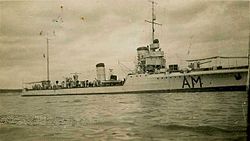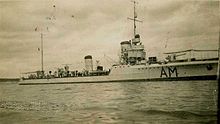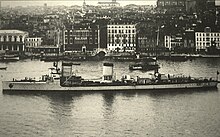Ardimentoso
|
The destroyer Ardimentoso
|
||||||||||||||||||||||
|
||||||||||||||||||||||
|
||||||||||||||||||||||
|
||||||||||||||||||||||
|
||||||||||||||||||||||
The Ardimentoso of the Italian Regia Marina was originally a large torpedo boat of the 1913 official draft of the German Imperial Navy that was put into service for them in December 1916 as S 63 . The boat, built by the Schichau shipyard in Elbing , had to be delivered to Italy in 1920 and was re-armed there as Ardimentoso in the service of the Navy in October 1925.
The boat was used as a school boat from 1931 and was painted and scrapped in 1939.
history
The large torpedo boats of the 1913 official draft were a departure from the 1911 preliminary draft and an attempt to procure smaller and inexpensive boats. The new design reached the size of the British destroyer and the later boats of the series such as S 63 came into service with three 10.5 cm cannons. They were the first torpedo boats of the Imperial Navy to be powered only by oil and the largest class in terms of numbers with 71 boats completed between 1914 and 1917.
The S 63 manufactured by the Schichau shipyard belonged to the third series of boats built by the shipyard according to the official draft of 1913 after the 79.6 m long S 31 to S 36 and S 49 to S 52 . From S 53 to S 66 the boats had a length of 83.1 m and displaced 919 t / 1170 t. Up to S 59 , the Schichau boats were armed with three 8.8 cm L / 45-C 14 guns upon delivery. From August 1916, the boats were equipped with three 10.5 cm L / 45-C 16 Tk guns when they were completed. Some of the boats previously delivered have been upgraded accordingly.
S 63 was started in Elbing in 1915 and was launched on May 27, 1916 as the 21st Schichau boat of the 1913 type. In December 1916 S 63 was taken over by the Imperial Navy and joined the VI. Torpedo boat flotilla.
Calls
The VI. Torpedo boat flotilla with S 63 moved to Flanders at the end of January 1917 . Since the British were aware of the German plans, the Harwich Force was supposed to put the flotilla on the transfer trip. Two German boats were damaged, but S 50 was able to torpedo the British destroyer Simoom , which then had to be sunk.
In autumn 1917, the flotilla belonged to the “Special Association of the Baltic Sea” of the deep sea fleet , which supported the landing company for the occupation of the Baltic islands of Saaremaa (Ösel), Hiiumaa (Dagö) and Muhu (Moon) ( company Albion ). S 63 formed the 13th half-flotilla deployed there with V 82 , S 61 , S 64 and V 74 . The boat was used again in Flanders in 1918 and was instrumental in the defense against the British landing company in Zeebrugge on the night of April 23rd to 24th, 1918.
The boat did not belong to the units interned in Scapa Flow , but was used by the Iron Flotilla , a volunteer association of the Provisional Imperial Navy , in the North Sea. It was then delivered to the Entente Powers via Cherbourg on May 23, 1920 . The delivery took place together with V 116 and B 97 , which were also given to Italy, and S 113 , H 146 and H 147 , which remained in France.
In Italian service
The three torpedo boats delivered to Italy came into the service of the Italian Regia Marina , with only the large destroyer V 116 coming into service unchanged as "Esploratore" Premuda . The other two were rebuilt and re-armed. The B 97 became the "Esploratore leggero" Cesare Rossarol with a 12 cm twin gun on the foredeck and a single gun on the stern.
S 63 was rebuilt by October 1925. The three 105 mm guns were replaced by three 100 mm L / 47 Škoda cannons. These two 40-mm automatic L / 39- came Vickers Terni -M.1917 guns on the fuselage sides at the height of the rear chimney and two 6.5-mm L / 80- Breda - machine guns on the bridge construction. The torpedo armament was reduced to two torpedo tubes of 500 mm caliber. The Kuhl was closed and the raised forecastle was pulled through to the bridge, a measure that significantly improved seaworthiness. As a result of these changes, the normal operational displacement increased to 1050 tons and was 1130 tons at full load. When the boat began service in the Regia Marina as "Cacciatorpediniere" Ardimentoso in October 1925, it had a crew of 111 men.
In 1928 the Ardimentoso was rebuilt again and the forecastle was connected to the bridge house. From 1931 the destroyer served in Pola as a training ship for torpedo use. Further changes were made for this task: A twin torpedo tube set for 450 mm torpedoes was also installed.
In 1938, disarmament began on the destroyer, which was struck off the fleet list in February 1939 and sold for scrapping. Since the demolition of the French Pierre Durand in 1934, the significantly modified Ardimentoso ex S 63 was the last boat of the largest torpedo boat class of the former German Imperial Navy with 71 boats.
Renewed use of the name
In 1942 the Italian Navy received another Ardimentoso during World War II . She was a torpedo boat of the Ciclone class , which by design was more of a destroyer escort. In 1949 she was given to the Soviet Union as Lutyj (Лютый) with the sister ships Animoso as Ladnyj (Ладный) and Fortunale as Letnyj (Лётный) , which separated the boats in 1960.
Individual evidence
- ↑ As has been customary with the procurement of torpedo boats for the Imperial Navy since the beginning of the century, the construction contracts went to the shipyard of Friedrich Schichau in Elbing, the Kruppsche Germania shipyard in Kiel and the AG Vulcan in Stettin , after which the boats with the first letters of the shipyards ( S, G, V) and consecutive numbers.
- ↑ Gröner: The German Warships 1815-1945 , p. 53 ff.
- ↑ a b Gröner, p. 55.
- ↑ Newbolt: NAVAL OPERATIONS , Vol. 4
- ↑ Het Verhaal van de Torpedo Boat V69 (Dutch)
- ↑ HMS Simoom , J.Brown BauNr. 455, 975/1173 t, October 30, 1916 launched
- ^ Gary Staff: Operation Albion: The Attack On The Baltic Islands .
- ↑ Gerhard P. Gros: The war at sea 1914-1918. The war in the North Sea. Vol. 7, critical edition, Hamburg 2006, pp. 309-311.
- ↑ Marine-Nachrichtenblatt No. 1, p. 32 ff.
literature
- Erich Gröner , Dieter Jung, Martin Maass: The German warships 1815-1945 . Volume 2, Bernard & Graefe Verlag, Koblenz 1983, ISBN 3-7637-4801-6 .
- Henry Newbolt: History of the Great War - NAVAL OPERATIONS . Vol. 4, Longmans, Green, London 1928.
Web links
- Large torpedo boat 1913 , on german-navy.de
- Henry Newbolt: History of the Great War - Naval Operations , Vol. 4, Longmans, Green, London 1928 , on naval-history.net
- Ardimentoso destroyer (1916/1920) - Regia Marina (Italy) , on navypedia.org
- Sos Ardimentoso - Betasom - XI Gruppo Sommergibili Atlantici





